
The Bank of Italy is the Italian member of the Eurosystem and has been the monetary authority for Italy from 1893 to 1998, issuing the Italian lira. Since 2014, it has also been Italy's national competent authority within European Banking Supervision. It is located in Palazzo Koch, via Nazionale, Rome.

The Quirinal Hill is one of the Seven Hills of Rome, at the north-east of the city center. It is the location of the official residence of the Italian head of state, who resides in the Quirinal Palace; by metonymy "the Quirinal" has come to stand for the Italian president. The Quirinal Palace has an extension of 1.2 million sq ft (110,000 m2).

The Capitolium or Capitoline Hill, between the Forum and the Campus Martius, is one of the Seven Hills of Rome.
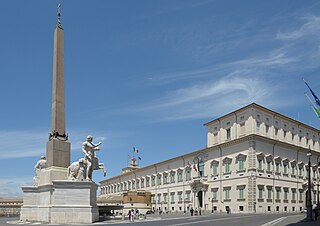
The Quirinal Palace is a historic building in Rome, Italy, one of the three current official residences of the President of the Italian Republic, together with Villa Rosebery in Naples and the Tenuta di Castelporziano, an estate on the outskirts of Rome, some 25 km from the centre of the city. It is located on the Quirinal Hill, the highest of the seven hills of Rome in an area colloquially called Monte Cavallo. It has served as the residence for thirty popes, four kings of Italy and twelve presidents of the Italian Republic.
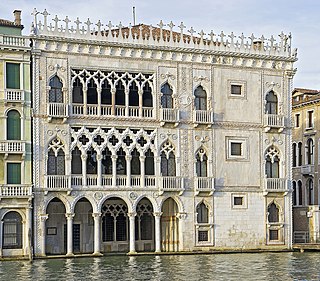
The Ca' d'Oro, or Palazzo Santa Sofia, is a palace on the Grand Canal in Venice, northern Italy. Ca' d'Oro or Cadoro translates to "House of Gold" or "Golden House" in English because of the gilt and polychrome external decorations that once adorned its walls. It was designed by Marino Contarini and later restored by Baron Giorgio Franchetti. In 1927, the building was converted into a museum and since then has been known as the Galleria Giorgio Franchetti alla Ca' d'Oro.

The Capitoline Museums are a group of art and archaeological museums in Piazza del Campidoglio, on top of the Capitoline Hill in Rome, Italy. The historic seats of the museums are Palazzo dei Conservatori and Palazzo Nuovo, facing on the central trapezoidal piazza in a plan conceived by Michelangelo in 1536 and executed over a period of more than 400 years.
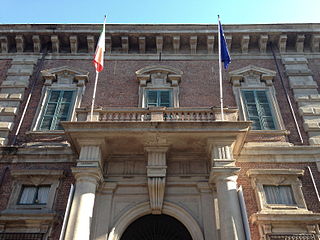
Palazzo Brera or Palazzo di Brera is a monumental palace in Milan, in Lombardy in northern Italy. It was a Jesuit college for two hundred years. It now houses several cultural institutions including the Accademia di Brera, the art academy of the city, and its gallery, the Pinacoteca di Brera; the Orto Botanico di Brera, a botanical garden; an observatory, the Osservatorio Astronomico di Brera; the Istituto Lombardo Accademia di Scienze e Lettere, a learned society; and an important library, the Biblioteca di Brera.

Venetian Gothic is the particular form of Italian Gothic architecture typical of Venice, originating in local building requirements, with some influence from Byzantine architecture, and some from Islamic architecture, reflecting Venice's trading network. Very unusually for medieval architecture, the style is at its most characteristic in secular buildings, with the great majority of surviving examples of the style being secular.

French Renaissance architecture is a style which was prominent between the late 15th and early 17th centuries in the Kingdom of France. It succeeded French Gothic architecture. The style was originally imported from Italy after the Hundred Years' War by the French kings Charles VII, Louis XI, Charles VIII, Louis XII and François I. Several notable royal châteaux in this style were built in the Loire Valley, notably the Château de Montsoreau, the Château de Langeais, the Château d'Amboise, the Château de Blois, the Château de Gaillon and the Château de Chambord, as well as, closer to Paris, the Château de Fontainebleau.
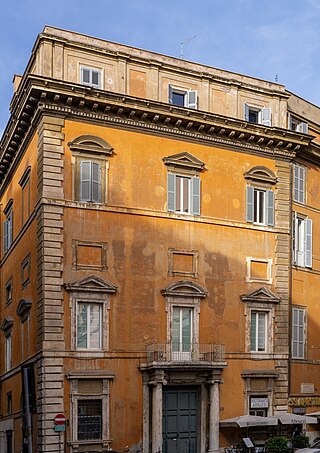
The Palazzo Muti is a large townhouse in the Piazza dei Santi Apostoli, Rome, Italy, built in 1644. Together with the neighboring Palazzo Muti Papazzurri, it originally formed part of a complex of adjoining palazzi and other houses owned by the Muti Papazzurri family. During the 18th century this entire range of buildings was, by courtesy of the pope, the residence of the House of Stuart government in exile in Rome. They were recognised by the Catholic Church and the Jacobite movement as the rightful kings of Great Britain and Ireland. The Palazzo Muti should not be confused with the Palazzo Muti Papazzurri in the Piazza della Pilotta which was designed by Mattia de' Rossi in 1660.
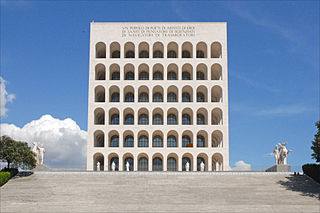
The Palazzo della Civiltà Italiana, also known as the Palazzo della Civiltà del Lavoro, or in everyday speech as the Colosseo Quadrato, is a building in the EUR district in Rome. It was designed in 1938 by three Italian architects: Giovanni Guerrini, Ernesto La Padula, and Mario Romano. The building is an example of Italian Rationalism and fascist architecture with neoclassical design, representing romanità, a philosophy which encompasses the past, present, and future all in one. The enormity of the structure is meant to reflect the fascist regime's new course in Italian history. The design of the building draws inspiration from the Colosseum with rows of arches. According to legend, the structure's six vertical and nine horizontal arches are correlated to the number of letters in the Italian dictator Benito Mussolini's name.

Palazzo Borghese is a palace in Rome, Italy, the main seat of the Borghese family. It was nicknamed il Cembalo due to its unusual trapezoidal groundplan; its narrowest facade faces the River Tiber. The entrance at the opposite end of the building, the "keyboard" of the cembalo, faces onto the Fontanella di Borghese, with another in a great flanking facade to the Piazza Borghese that is extended by a slightly angled facade leading down Via Borghese towards the river. Both these entrances lead into a large courtyard on one side of which is a two level open arcade, with paired Doric and Ionic columns, that frames the garden beyond.

The Chigi Palace is a palace and former noble residence in Rome which is the seat of the Council of Ministers and the official residence of the Prime Minister of Italy. It is located in the Piazza Colonna, next to Palazzo Montecitorio, seat of the Chamber of Deputies.

Via Nazionale is a street in Rome from Piazza della Repubblica leading towards Piazza Venezia.

Palazzo Antonini also known as Palazzo Palladio and Palazzo Antonini-Maseri, is a palazzo in Udine, northern Italy. It was designed by Italian Renaissance architect Andrea Palladio in the middle of the 16th century for the Antonini family, owner of various other palaces in Udine.

The Palace of Justice, colloquially nicknamed il Palazzaccio, is the seat of the Supreme Court of Cassation and the Judicial Public Library of Italy. It is located in the Prati district of Rome, facing Piazza dei Tribunali, Via Triboniano, Piazza Cavour, and Via Ulpiano.

Palazzo Dolfin Manin is a palace in the sestiere of San Marco on the Canal Grande of Venice, northern Italy. It is located near the Palazzo Bembo and Palazzo Dandolo Paolucci, not far from the Rialto Bridge.

Antonio Cipolla was an Italian architect, active in an academic neo-Renaissance style.

The National Bank of the Kingdom of Italy, known from 1850 to around 1870 as the National Bank of the Sardinian States, was a bank of issue of the Kingdom of Sardinia then the Kingdom of Italy after unification in 1861. Despite its name, it had no monopoly on money issuance, in a financial system that proved prone to instability. It was successively headquartered in Genoa (1850-1853), Turin (1850-1865), Florence (1865-1873), and Rome (1873-1893). Following the controversial failure of Banca Romana, the National Bank was eventually merged with several peers in 1893 to form the Bank of Italy.

The Palazzo delle Poste is an administrative building which serves as the Poste Italiane headquarters in Grosseto, Tuscany. It was designed by architect Angiolo Mazzoni and completed in 1932. The building features an exterior in a monumental style, typical of the Fascist architecture, while the interior is characterized by a closer alignment with the modern principles of Italian rationalism. It also houses sculptures by Napoleone Martinuzzi and Domenico Ponzi.





















